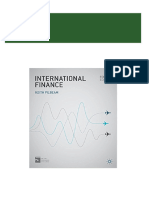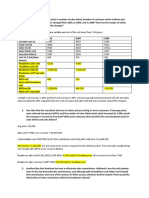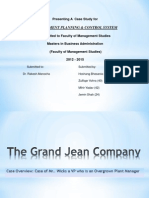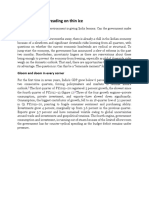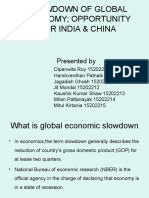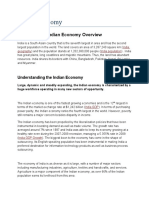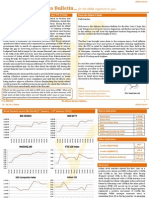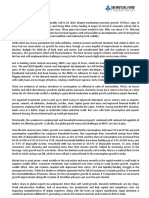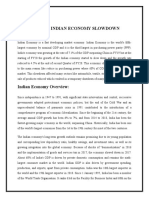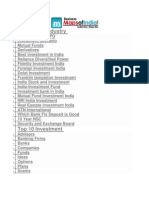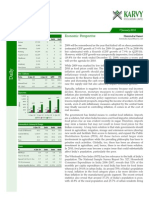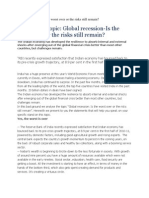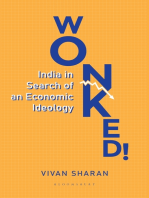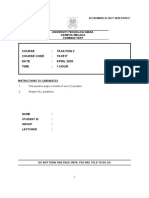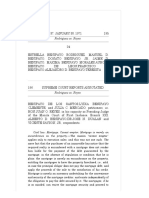0 ratings0% found this document useful (0 votes)
49 viewsHallenges For The Indian Economy in 2017
Hallenges For The Indian Economy in 2017
Uploaded by
Asrar SheikhThe document outlines five key challenges for the Indian economy in 2017:
1. A vulnerable rupee due to rising oil prices increasing India's trade deficit and potentially jeopardizing current account balances if export growth is not sustained.
2. Capital inflows may decrease due to foreign investors being jittery and net FDI/remittances losing strength, putting pressure on the rupee.
3. Fiscal health and macroeconomic stability could be impacted if oil prices continue to rise, increasing subsidies and inflation.
4. A growing divergence between steady consumption but declining investment for three quarters.
5. Demonetization reducing consumption demand and potentially disturbing capital expenditure plans especially for small and medium enterprises.
Copyright:
© All Rights Reserved
Available Formats
Download as ODT, PDF, TXT or read online from Scribd
Hallenges For The Indian Economy in 2017
Hallenges For The Indian Economy in 2017
Uploaded by
Asrar Sheikh0 ratings0% found this document useful (0 votes)
49 views7 pagesThe document outlines five key challenges for the Indian economy in 2017:
1. A vulnerable rupee due to rising oil prices increasing India's trade deficit and potentially jeopardizing current account balances if export growth is not sustained.
2. Capital inflows may decrease due to foreign investors being jittery and net FDI/remittances losing strength, putting pressure on the rupee.
3. Fiscal health and macroeconomic stability could be impacted if oil prices continue to rise, increasing subsidies and inflation.
4. A growing divergence between steady consumption but declining investment for three quarters.
5. Demonetization reducing consumption demand and potentially disturbing capital expenditure plans especially for small and medium enterprises.
Original Description:
10 major challenges faced by the Indian economy.
Original Title
Hallenges for the Indian Economy in 2017
Copyright
© © All Rights Reserved
Available Formats
ODT, PDF, TXT or read online from Scribd
Share this document
Did you find this document useful?
Is this content inappropriate?
The document outlines five key challenges for the Indian economy in 2017:
1. A vulnerable rupee due to rising oil prices increasing India's trade deficit and potentially jeopardizing current account balances if export growth is not sustained.
2. Capital inflows may decrease due to foreign investors being jittery and net FDI/remittances losing strength, putting pressure on the rupee.
3. Fiscal health and macroeconomic stability could be impacted if oil prices continue to rise, increasing subsidies and inflation.
4. A growing divergence between steady consumption but declining investment for three quarters.
5. Demonetization reducing consumption demand and potentially disturbing capital expenditure plans especially for small and medium enterprises.
Copyright:
© All Rights Reserved
Available Formats
Download as ODT, PDF, TXT or read online from Scribd
Download as odt, pdf, or txt
0 ratings0% found this document useful (0 votes)
49 views7 pagesHallenges For The Indian Economy in 2017
Hallenges For The Indian Economy in 2017
Uploaded by
Asrar SheikhThe document outlines five key challenges for the Indian economy in 2017:
1. A vulnerable rupee due to rising oil prices increasing India's trade deficit and potentially jeopardizing current account balances if export growth is not sustained.
2. Capital inflows may decrease due to foreign investors being jittery and net FDI/remittances losing strength, putting pressure on the rupee.
3. Fiscal health and macroeconomic stability could be impacted if oil prices continue to rise, increasing subsidies and inflation.
4. A growing divergence between steady consumption but declining investment for three quarters.
5. Demonetization reducing consumption demand and potentially disturbing capital expenditure plans especially for small and medium enterprises.
Copyright:
© All Rights Reserved
Available Formats
Download as ODT, PDF, TXT or read online from Scribd
Download as odt, pdf, or txt
You are on page 1of 7
Here are five key challenges for the Indian
economy in 2017
Vulnerable rupee. After the deal on production cuts,
crude oil prices are rising and, if that continues, it will
push up Indias trade deficit depending on how the
countrys export sector performs. Indias merchandise
export grew at a healthy 9.6 percent in October, but
given the bleak global macroeconomic environment,
growing protectionism, uncertainty created by the
referendums in the UK and Italy, and the U.S.
presidential election, its doubtful that export growth
momentum will be maintained. If Indias export growth
is not sustained, rising oil prices will jeopardize its
current account balances.
Capital inflows in the form of foreign portfolio
investment (FPI) or foreign direct investment (FDI)
could offer support where export growth momentum
may drop off. However, foreign institutional investors
are jittery while net FDI inflows as well as remittances
are losing strength. In the last month, FPIs have pulled
out over $5 billion from Indias debt market. As
expected, the U.S. Federal Reserve raised its
benchmark interest rate by 25 basis points and gave
clear hints at future rate hikes. On the other hand, the
Reserve Bank of India (RBI) has reduced its policy rates
by a whopping 175 basis points since January 2015,
and there is pressure to prune it further even though
RBI avoided a recent rate cut. The U.S. Federal
Reserves action will reduce the relative interest rate
gap between India and the U.S., and may induce capital
outflows from Indias debt market, which will put
pressure on the rupee.
Fiscal health and macroeconomic stability.
Continued low commodity pricesespecially of crude
oilhave helped the Indian government contain its
fiscal deficit and rein in inflation. However, oil prices are
hardening again after the successful conclusion of an
OPEC deal on production cuts and the willingness of
non-OPEC members to cooperate. That is not good
news for Indias current account balances. Its likely to
push up the governments subsidy bill and aid inflation.
That may (even if partly) explain why RBI kept the
benchmark interest rate unchanged in its last revision.
Growing divergence between consumption and
investment. While consumption has remained steady
(growing at 6-7 percent)at least until demonetization
was announced in early Novemberinvestment, as
measured by gross fixed capital formation, has been in
negative territory for the last three quarters. This is due
to companies deleveraging their balance sheets,
operating on a lower capacity (below 75 percent) and a
demand slump in both domestic and export markets. It
fell 1.9 percent in the last quarter of the 2015-16
financial year, and then fell 3.1 percent in the first
quarter and 5.6 percent in the second quarter of the
current financial year respectively. The decline in
investment is a problem, particularly if oil prices
increase, and given the increased government
spending for the 7th Pay Commission, both of which will
limit the governments ability to spend on infrastructure
and other ventures.
Demonetization. As if a slump in investment was not
enough, demonetization induced a reduction in
consumption demand. The resultant decline in the sales
of businesses will disturb CapEx plans, especially in the
SMEs sector, which accounts for 45 percent of Indias
manufacturing GDP and 40 percent of its merchandise
exports, and may reduce anything between 0.5 to 2
percent of the countrys GDP.
Also, according to the RBI, most of the demonetized
currency notes will return to the banking system, so no
windfall gains for the government from destruction of
black money to the extent of 20 percent of the value of
500 and 100 currency notes in circulation as initially
estimated. Now the government is claiming that the
move will encourage digitization of financial
transactions. It will, but on a smaller scale than is
thought, given the low access and concerns on quality
of Internet in smaller towns and rural areas.
The non-performing assets menace. Despite a
series of measures to deal with bad loans by the
government and the RBI, the non-performing assets of
state owned banks increased to INR 63.03 trillion ($930
billion) on 30 September from INR 55.03 trillion on 30
June. Many analysts claim that things are not so bad for
private sector banks, but they have avoided the risky
corporate loans necessary to support industrial
expansion. The high share of bank loans given by public
sector banks could also be a result of banks offering
loans sanctioned selectively by bank employees to
favor crony capitalists rather than taking commercial
considerations into account. This is a problem the
Indian government has not been able to tackle
effectively yet.
Indian banks have also been forced to write off bad
loans. As a result of an increase in non-performing
assets and write-offs, banks are not able to pass on the
benefit of policy rate cuts (175 basis points since
January 2015) to borrowers, especially those in the
retail sector and SMEs. This will have implications on
credit-financed demand in sectors such as automobile
and housing that have backward and forward linkages
for several upstream and downstream industries such
as steel, auto components and cement.
Still Room for Optimism
Despite these challenges, India is expected to be
among the fastest-growing large economies in the
world in 2017. Mitigating these risks is important,
particularly given global economic uncertainty, and
failure to do so may prevent the economy from
realizing its growth potential in the coming year.
10 major challenges faced by the
Indian economy.
This post will enlighten you about 10 major challenges
faced by the Indian economy. Not only this, the
following points will prove out to be useful in your
general awareness preparation.
Since 1991, the Indian economy has witnessed
developments in trade & commerce, infrastructure,
technology, and more. However, the Indian economy
still faces various challenges. Lets go through them.
1. Inflation
The increase in prices of food products and other goods
& services in India is an ever increasing problem.
Current inflation rate in India is 6.51%. For instance, in
2013, the inflation rate was approximately 11%, despite
the growth rate being 4.8%. From this data, we can
infer that inflation is not because of excess demand,
but is also caused by cost push inflationary factors. For
example, constraints in agriculture cause rise in food
prices, which further leads to inflation.
2. Poor educational standards
Around 22-25% of the population in India lives Below
Poverty Line (BPL). They are unable to afford quality
education and as a result literacy rate declines.
Education standard is worse in villages & rural areas.
Around 40% of the Indian women are illiterate. This
hampers economic development.
3. Poor infrastructure and rural development
Nearly 70% of the Indian population lives in rural areas.
Many of them dont have access to basic amenities like
water, electricity, proper roads, and medical facilities. It
is, therefore, the need of the hour to take their
economic and social development to the next level.
Only the urban and metropolitan cities have witnessed
improvement in infrastructure and facilities, for
instance, the Golden Quadrilateral highway network in
India has enhanced road connectivity across major
cities in the country.
Investments and necessary measures are necessary to
improve infrastructure and develop the existing ones
(railways and roads; technology; education; health;
small and medium enterprises) in rural areas to
augment growth across the country.
4. Sustainable and inclusive growth
In 2015-16, Indias GDP was around 7.5%, which is an
essential to meet countrys development standards.
Significant challenges for sustainable and inclusive
growth still persist in our country, such as the fiscal
deficit, slowing investment and industrial credit.
5. Demographic dividend and regional influence
As per a survey, 250 million Indians are categorized in
the middle class. Bilateral and multilateral
communications can strengthen the relationship among
Asian countries. Initiatives such as spice route can
expand opportunities for trade and cultural relations.
6. Large budget deficit
Among the developing countries, India has one of the
largest budget deficits. Excluding the subsidies, the
budget deficit is nearly 8% of GDP.
7. Rigid labour laws
As per a rule, firms having 100+ employees cannot
terminate them without the governments permission.
This discourages firms from expanding to over 100
people. Trades unions take a stronger stand and the
government doesnt tackle such sensitive labour laws.
8. Inefficient agriculture
Ours is an agrarian economy with 51% of the workforce
employed in agricultural activities. Agriculture produces
17.4% of economic output. This is the most inefficient
sector with the output being very low as compared to
the employed workforce.
9. Equalising development across states
The diversity of cultures and traditions across India is
remarkable. However, wide variation in socio-economic
development is a challenge faced by our economy.
Policies should not be biased toward specific states.
10. Slowdown in growth
In 2013-14, the rate of economic growth was 4-5%. This
is a major cause for concern as India needs a high
growth rate.
Stay updated for more articles on current affairs.
Lets glance through expected questions.
You might also like
- (eBook PDF) International Finance 4th edition by Keith Pilbeam All Chapters Instant DownloadDocument41 pages(eBook PDF) International Finance 4th edition by Keith Pilbeam All Chapters Instant Downloadgeerahoihan100% (2)
- E0311 Hallstead JewelersDocument2 pagesE0311 Hallstead Jewelersaltemurcan kursunlu100% (1)
- Case Study - Grand Jean CompanyDocument16 pagesCase Study - Grand Jean Companyyadavmihir63100% (1)
- This Study Resource Was: Answer of Bond ValuationDocument9 pagesThis Study Resource Was: Answer of Bond Valuationmuhammad hasan100% (2)
- Course: Macro Economics Course Code: Bmt6111 SEMESTER: Tri Semester'2019-20Document9 pagesCourse: Macro Economics Course Code: Bmt6111 SEMESTER: Tri Semester'2019-20Gopinath KNo ratings yet
- Edutap Mock - IFSCA Phase 2Document52 pagesEdutap Mock - IFSCA Phase 2prashantdash5834No ratings yet
- Indian Economy - Nov 2019Document6 pagesIndian Economy - Nov 2019Rajeshree JadhavNo ratings yet
- Indias Economic WoesDocument3 pagesIndias Economic WoesresfreakNo ratings yet
- Problems Facing Indian EconomyDocument2 pagesProblems Facing Indian Economymeeraraj_11No ratings yet
- Foreign Direct Investment in Banking Sector by Shubham ShuklaDocument12 pagesForeign Direct Investment in Banking Sector by Shubham ShuklaShubham ShuklaNo ratings yet
- Niveshak Niveshak: India Vision 2020Document24 pagesNiveshak Niveshak: India Vision 2020Niveshak - The InvestorNo ratings yet
- Masala 2011Document9 pagesMasala 2011gauhar77No ratings yet
- Indian EconomyDocument38 pagesIndian EconomyIQAC VMDCNo ratings yet
- Investment in IndiaDocument39 pagesInvestment in IndiaJohnyNo ratings yet
- Indian EconomyDocument13 pagesIndian EconomyPraval SaiNo ratings yet
- Eic AnalysisDocument17 pagesEic AnalysisJaydeep Bairagi100% (1)
- Ndia Is The 11th Largest Economy in The World by Nominal GDP and 4th Largest by Purchasing Power ParityDocument3 pagesNdia Is The 11th Largest Economy in The World by Nominal GDP and 4th Largest by Purchasing Power ParityShubhangi PanpatilNo ratings yet
- India economic outlook _ Deloitte InsightsDocument12 pagesIndia economic outlook _ Deloitte InsightsabrarshawlofficialNo ratings yet
- LenovoDocument84 pagesLenovoasifanis100% (1)
- IndiaEconomicGrowth SDocument16 pagesIndiaEconomicGrowth SAmol SaxenaNo ratings yet
- SPEX Issue 22Document10 pagesSPEX Issue 22SMU Political-Economics Exchange (SPEX)No ratings yet
- Summer Internship Report On LenovoDocument74 pagesSummer Internship Report On Lenovoshimpi244197100% (1)
- Slowdown of Global Economy Opportunity For India & ChinaDocument13 pagesSlowdown of Global Economy Opportunity For India & ChinaMitul Kirtania50% (2)
- Indian EconomyDocument7 pagesIndian EconomyGaurav VijNo ratings yet
- Performance ApppraidDocument81 pagesPerformance ApppraidManisha LatiyanNo ratings yet
- Abhyaas Business Bulletin - January 16th, 2012Document4 pagesAbhyaas Business Bulletin - January 16th, 2012Abhyaas Edu CorpNo ratings yet
- Economics IA MACRODocument7 pagesEconomics IA MACROAayush KapriNo ratings yet
- Comparative Picture of The Indian Economy and Fugitive Economic Offender Act 2018Document19 pagesComparative Picture of The Indian Economy and Fugitive Economic Offender Act 2018Dishant SinghNo ratings yet
- Challenges and Coners of RbiDocument17 pagesChallenges and Coners of RbiParthiban RajendranNo ratings yet
- August 2019Document2 pagesAugust 2019Kiran MNo ratings yet
- Foreign Direct Investment and Its Impact: Vivekanandha College of Arts and Sciences For Womens ElayampalayamDocument8 pagesForeign Direct Investment and Its Impact: Vivekanandha College of Arts and Sciences For Womens Elayampalayamanon_209785390No ratings yet
- We Expect Liquidity To Be Tight Till December, at Least. - J P MorganDocument5 pagesWe Expect Liquidity To Be Tight Till December, at Least. - J P MorganAlpesh PatelNo ratings yet
- Helping You Spot Opportunities: Investment Update - August, 2013Document55 pagesHelping You Spot Opportunities: Investment Update - August, 2013akcool91No ratings yet
- Indian Economy - Challenges & Opportunities PDFDocument3 pagesIndian Economy - Challenges & Opportunities PDFDhiraj MeenaNo ratings yet
- Project KMFDocument96 pagesProject KMFLabeem SamanthNo ratings yet
- Managerial EconomicsDocument7 pagesManagerial EconomicsTanya Miriam SimonNo ratings yet
- Lecture by Dr. Raghuram Rajan, Governor, RBI On IndiaDocument2 pagesLecture by Dr. Raghuram Rajan, Governor, RBI On IndiaDeepak SharmaNo ratings yet
- Bank Merger: Why Merger Is Good? - Benefits For Various StakeholdersDocument5 pagesBank Merger: Why Merger Is Good? - Benefits For Various StakeholdersAnirban RoyNo ratings yet
- RecessionDocument2 pagesRecessionnikunjgNo ratings yet
- Indian Economy An OverviewDocument14 pagesIndian Economy An OverviewVinod Kumar TiwaryNo ratings yet
- Indian EconomyDocument12 pagesIndian Economyarchana_anuragiNo ratings yet
- Economic Analysis of India and Industry Analysis of Chemical IndustryDocument28 pagesEconomic Analysis of India and Industry Analysis of Chemical IndustrySharanyaNo ratings yet
- Vision: Personality Test Programme 2019Document5 pagesVision: Personality Test Programme 2019sureshNo ratings yet
- OwowDocument46 pagesOwowprasadsangamNo ratings yet
- Present Economic SlowdownDocument8 pagesPresent Economic SlowdownGopinath KNo ratings yet
- Present Indian Economy SlowdownDocument8 pagesPresent Indian Economy SlowdownGopinath KNo ratings yet
- Present Indian Economy SlowdownDocument8 pagesPresent Indian Economy SlowdownGopinath KNo ratings yet
- Key Macro-Economic Challenges For India, at Present, Include: InflationDocument5 pagesKey Macro-Economic Challenges For India, at Present, Include: InflationAmita SinwarNo ratings yet
- Ipo 1Document13 pagesIpo 1Prakash TripurariNo ratings yet
- ShambhaviDocument4 pagesShambhaviShambhavi DoddawadNo ratings yet
- IndiaDocument3 pagesIndiaAbhishek SinhaNo ratings yet
- Budget 2011 Is An Item Number. by Sheila, For Munni!Document6 pagesBudget 2011 Is An Item Number. by Sheila, For Munni!pranabanandarathNo ratings yet
- Fearful Symmetry Nov 2011Document4 pagesFearful Symmetry Nov 2011ChrisBeckerNo ratings yet
- Swot Analysis Indian Banking: From The Selectedworks of Yogendra SisodiaDocument6 pagesSwot Analysis Indian Banking: From The Selectedworks of Yogendra SisodiasamdhathriNo ratings yet
- Artcles Reforming IndiaDocument7 pagesArtcles Reforming Indiaapi-3833893No ratings yet
- India Vs Major Emerging EconomiesDocument1 pageIndia Vs Major Emerging EconomiesNaveen PalNo ratings yet
- Assignment On INDIAN EconomyDocument16 pagesAssignment On INDIAN Economyprithvi yadavNo ratings yet
- Daily: Economic PerspectiveDocument3 pagesDaily: Economic PerspectiveDEEPAK KUMAR MALLICKNo ratings yet
- Global RecessionDocument2 pagesGlobal RecessionshalinichNo ratings yet
- This Time, India's Rapid Economic Growth Has Legs - Nikkei AsiaDocument5 pagesThis Time, India's Rapid Economic Growth Has Legs - Nikkei AsiakavitaashokNo ratings yet
- Maha Jafar On PepsicoDocument53 pagesMaha Jafar On PepsicoSalman NawazNo ratings yet
- Faisalabad Electric Supply Company LTD.: Annual Adjustment/Indexation of Distribution Margin (DM) For FY 202 1-22Document91 pagesFaisalabad Electric Supply Company LTD.: Annual Adjustment/Indexation of Distribution Margin (DM) For FY 202 1-22Zulqernain HaiderNo ratings yet
- Dmgt512 Financial Institutions and ServicesDocument265 pagesDmgt512 Financial Institutions and ServicesASIF100% (1)
- SM Senior Contract SpecialistDocument6 pagesSM Senior Contract SpecialistAhmed Parachalil0% (1)
- Document (3) Unit 5 Investment in Mutual FundDocument8 pagesDocument (3) Unit 5 Investment in Mutual FundManjunath KNo ratings yet
- Test PaperDocument27 pagesTest PaperAnand BandhuNo ratings yet
- PeriodicDocument1 pagePeriodicMaria Raven Joy ValmadridNo ratings yet
- AIA Engineering LimitedDocument11 pagesAIA Engineering LimitedAdesh SinghNo ratings yet
- Real Estate Pre-Work TemplateDocument5 pagesReal Estate Pre-Work TemplateInsiya MerchantNo ratings yet
- Course: Taxation 2 Course Code: TAX517 Date: APRIL 2020 Time: 1 HourDocument5 pagesCourse: Taxation 2 Course Code: TAX517 Date: APRIL 2020 Time: 1 Houranis izzatiNo ratings yet
- MathDocument3 pagesMathEman MahmoudNo ratings yet
- Rodriguez Vs Reyes, 37 SCRA 195Document18 pagesRodriguez Vs Reyes, 37 SCRA 195Marc Gar-ciaNo ratings yet
- Torres Vs CADocument2 pagesTorres Vs CACeCe Em100% (1)
- Hindalco Industries LTDDocument7 pagesHindalco Industries LTDVarun RanganathanNo ratings yet
- Master File and Country To Country Compliance Form 3CEAA, 3CEAB, 3EAC, 3CEAD, 3CEAE - Taxguru - inDocument8 pagesMaster File and Country To Country Compliance Form 3CEAA, 3CEAB, 3EAC, 3CEAD, 3CEAE - Taxguru - inSreejith KNo ratings yet
- CONTRACTS Project - Aman KumarDocument16 pagesCONTRACTS Project - Aman KumarAman KumarNo ratings yet
- Trident Oil & Gas Investment PlanDocument9 pagesTrident Oil & Gas Investment PlanIdowu MayowaNo ratings yet
- Espresso SoftwareDocument80 pagesEspresso SoftwareMuhammad IhsanNo ratings yet
- Tax Agents and PractitionersDocument5 pagesTax Agents and PractitionerskawaiimiracleNo ratings yet
- 9Document16 pages9Asal IslamNo ratings yet
- Sad 001 HLRPP Originator Checklist-RevisedDocument1 pageSad 001 HLRPP Originator Checklist-Revisedaileen_v21No ratings yet
- Interim Order in The Matter of Aspen Nirman India LimitedDocument20 pagesInterim Order in The Matter of Aspen Nirman India LimitedShyam SunderNo ratings yet
- Book Order FormDocument1 pageBook Order FormDIVYAKIRAN JYOTISHNo ratings yet
- Summer Training Finance Project On WORKING CAPITAL MANAGEMENTDocument82 pagesSummer Training Finance Project On WORKING CAPITAL MANAGEMENTPravin chavda100% (2)
- Term Paper On Dutch Bangla BankDocument7 pagesTerm Paper On Dutch Bangla Bankafdtzvbex100% (1)
